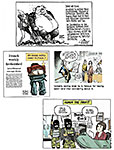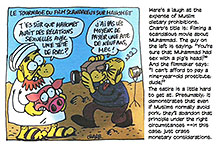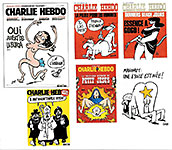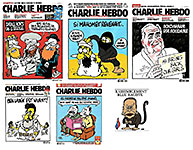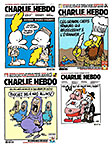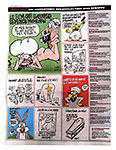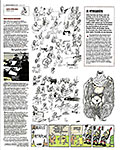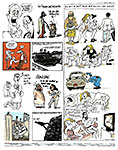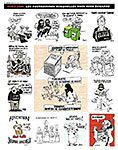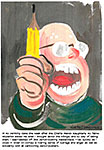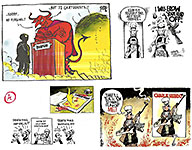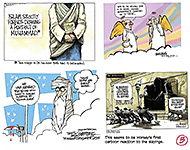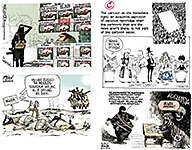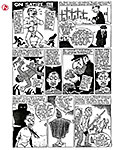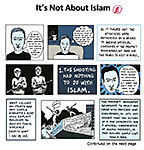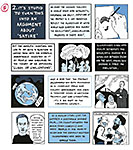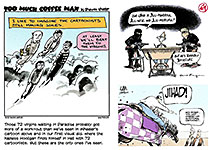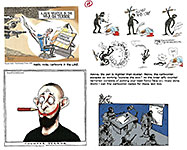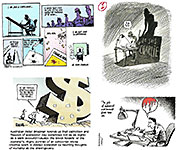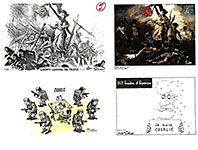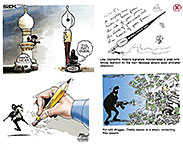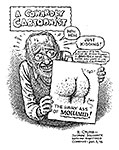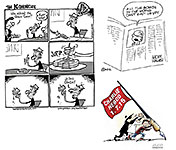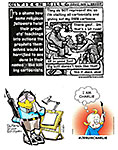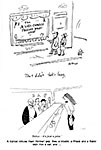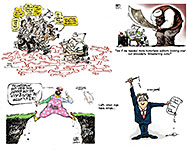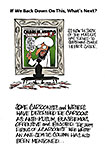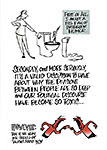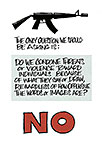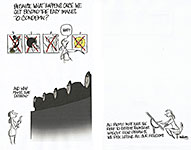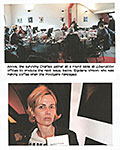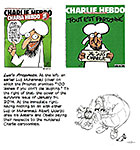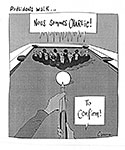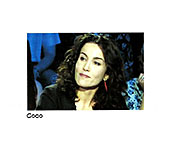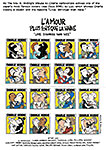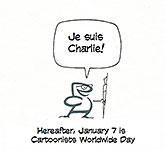 |
||||||||||||||||||||||
Opus 336: (January 29, 2015). In the wake of the tragic killing of cartoonists in the Paris offices of the satirical weekly, Charlie Hebdo, we return to the subject with a post-mortem discussion of security issues the attack provokes and offensiveness in cartoons, the phoney prohibition against depicting Muhammad, alleged Islamophobia at Charlie Hebdo (including an analysis of the paper’s cover cartoons), a survey of cartoonists’ reactions to the murders (Robert Crumb, Keith Knight, NCS’s Tom Richmond, Mad’s John Ficarra, Daryl Cagle’s massive online exhibit, Arab-American editoonist Khalil Bendib and others) and reports tracing the evolution of the “survivors” issue of Charlie Hebdo. At the end, a bibliography of articles in Print on censorship and related matters by Michael Dooley. Here’s what’s here, in order—:
POST-CHARLIE Security Issues Offensiveness in Cartoons Phoney Prohibition Against Depicting Muhammad Alleged Islamophobia in Charlie Hebdo Larry Flynt vs. Jerry Falwell
Analyzing Charlie Covers Interior Charlie Pages
EDITOONISTS REACTIONS IN U.S. AND ELSEWERE Khalil Bendib, Arab-American Cartoonist Robert Crumb, “Cowardly Cartoonist” Keith Knight John Ficarra, Editor of Mad National Cartoonists Society Exhibit NCS Prez Tom Richmond Daryl Cagle Extensive Online Exhibit for Downloading Future Self-censorship and External Pressures
Defend Freedom of Expression
POST MORTEM Correction: Eye Witness Account
SURVIVING Tracing the Evolution of the Survivors Issue Friday’s Editorial Meeting Friday Evening Informal Staff Gathering: Cartoonists’ Reactions, History of Charlie Monday and the Cover of the Survivors Issue
Bibliography of Print articles on censorship and related issues.
Our Motto: It takes all kinds. Live and let live. Wear glasses if you need ’em. But it’s hard to live by this axiom in the Age of Tea Baggers, so we’ve added another motto:.
Seven days without comics makes one weak. (You can’t have too many mottos.)
And our customary reminder: don’t forget to activate the “Bathroom Button” by clicking on the “print friendly version” so you can print off a copy of just this installment for reading later, at your leisure while enthroned. Without further adieu, then, here we go—:
POST-CHARLIE The World in the Wake of the Paris Murders THE KILLING of a dozen satirists at the offices of the magazine Charlie Hebdo the first week in January reverberated loudly throughout the world in the days that followed. Millions of people marched in protest through the streets of Paris led by political leaders from 40 countries, arms linked in solidarity. Thousands of rabid right anti-immigration advocates elsewhere rallied to protest the “Islamification” of Europe. In the Mideast, predictably, many Muslims (but not all) decried the publication of images of the Prophet Muhammad as “blasphemy”—punishable by death. In the squalid Muslim ghettos at the fringes of large French cities, Muslims feared fierce retaliation; mosques (and Jewish sites) were attacked. Cartoonists and journalists everywhere beat the drum for freedom of expression. The extraordinary outpouring of sympathy and solidarity among ordinary French citizens and those of other countries encourages me to think that we may have reached the tipping point in our relations with Islamist Hooliganism. Even Muslim nations are saying they are fed up with the radical extremists that prey upon innocent, unarmed people in the name of Allah. Some of those nations are even saying that they want to cooperate with Western countries to develop networks for sharing intelligence. That may go further in formulating a defense (even an offense?) than we’ve been able to go before. Two questions are currently preoccupying the gasbags in what they hope, for the sake of ratings and viewership, will be endless discussion: security and offensiveness in cartoons. Resolving each of these issues turns on questions of personal, individual liberty. How much liberty are we willing to give up in the name of enhanced security? How much freedom of expression are we willing to give up to appease fussy religious beliefs? As I said last time, a proper war against so-called Muslim extremists would not give the extremists what they want. It would not limit or reduce freedom—even in the name of security. Instead, it would increase freedom. It would immediately do away with airport security; we would no longer have to remove our shoes in order to board an airplane. By remaining free, we defeat the enemies of freedom—i.e., the radical Islamists, the Cutthroat CalipHATE and all its misbegotten ilk. Conversely, by beefing up security—we not only limit freedom: we admit to being fearful. And the radical Islamists win. And they are already winning. We may kill a few Muslim Hooligans after they’ve slaughtered unarmed people in offices or malls, but the Hooligans are still free to pick the time and place of their assaults. In reports of the Paris violence (seeking, perhaps, to make the incident more horrific by increasing the body count), the total dead mounted from 12 at Charlie Hebdo’s office to 20 city-wide—including those killed at the kosher grocery, plus the three murdering Hooligan thugs. But in Nigeria at virtually the same time, Boko Haram Hooligans were creating an apocalyptic horror by killing more than 2,000. This on the heels of the Hooligan attack on a school in Pakistan last month that produced 132 dead school children. As long as radical Islamists can commit such atrocities at will, we are losing. This is the propitious moment for the National Rambo Association to step forward with a demand that we all be armed by government fiat. We can then shoot terrorists on sight: dressed always in black with black masks, they are easily identifiable. Meanwhile, the demand for security whittles away at individual liberties. In France, pressure mounts for legislation akin to our “Patriot Act” which authorizes the government to pry into internet communications. It is not likely that freedom will prevail in the fashion I advocated a few sentences ago. Security will not relax: it will intensify. How can it not? The first demand of any citizenry of their government is for safety. No government can resist that demand and endure. And so we’ll see our freedom slowly erode over the coming years of our war with terrorism. And that war is, indeed, going to take years. Perhaps the rest of this century. The root causes of the international hooliganism are economic, not religious (despite what the Hooligans want us to believe), and it will take generations to eradicate them. We must do no less than eliminate poverty in the world because poverty, with its abject present and hopeless future, nurtures the discontent that breaks out in hooliganism of the most brutal sort that we’ve been witnessing. We are in for a long slog, and we must steel ourselves for it. We may hope, however, that freedom of expression will somehow abide. At first—way back in 2006 with the Danish Dozen—I was vaguely sympathetic with the Muslim point-of-view about depictions of Muhammad. The general notion is that depicting Muhammad may lead the simple-minded to worship his image instead of Allah. The dreaded idolatry dawns. And cartoons depicting Muhammad took this alleged “blasphemy” another step further: in the cartoons—because they are cartoons—the Prophet was being laughed at, mocked. For shame. Still, it seemed a decent and respectful thing to do, to refrain from ridiculing Islam by cartooning the Prophet. In the current brouhaha, PBS’s “News Hour” said it wouldn’t show any of the gross Charlie Hebdo images because they are likely to be offensive to Muslims; so out of respect for that religion, the “News Hour” declined to show the images. Thereby, the “News Hour” abdicated its journalistic responsibility—just as all American newspapers did in 2006 by declining to print any of the Danish Dozen. Had those images been made public, readers would realize just how small-minded some Islamist extremists are to take such excessive offense at these childish scrawls. So how is journalism supposed to behave in future? Must every religion be shown this kind of deference? Will we give up public displays of the Christmas spirit—no shopping sprees, no Santa Clauses on street corners, no Christmas sale advertising in newspapers—because Jehovah’s Witnesses do not believe in celebrating Christmas—and would therefore be offended by the spectacle of the Christmas Season with all its lights and tinsel frou-frou? Ironically, the prohibition against images of Muhammad is not shared by all Muslims. Nor do all those who object do so as hysterically as the extremist Hooligans do. Some Muslims are upset but only mildly. And through history, the prohibition about Muhammad’s image has not been universally supported among Muslims. In fact, there are hundreds of images of the Prophet scattered through the centuries—in paintings in museums and in private dwellings. And there are statues of Muhammad in public places. An 8-foot marble sculpture of the Prophet stood on the roof of a courthouse near Madison Square Park in Manhattan for more than 50 years until it was “quietly removed in 1955,” Rick Gladstone tells us at nytimes.com. “But a coalition of Muslim advocacy groups failed in a 1997 effort to seek the removal or alteration of a frieze containing a [presumed] likeness of Muhammad on the north wall of the Supreme Court’s main chamber. The Prophet is among 18 revered lawgivers decorating the Court’s interior” (among whom Moses is to be seen). The customary Muslim stance has been, for centuries, that Islam discourages images of Muhammad—just as it frowns on all images of creatures that are presumed to have souls. But there was no outright ban until fairly recent times. (In fact, one online source I consulted said the ban originated in 2005 with the Danish Dozen. That recently.) Sunni Muslims are more dedicated to prohibiting the images than Shiites, who, more or less, wink at offenses and let them be. So what’s a Westerner supposed to do? Oddly, as a result of a perverse but accurate logic, the Muslim objection to images of Muhammad has managed to turn Islam’s rationale on its head. By objecting so strenuously to images of the Prophet, those images have ironically become a kind of deification of Muhammad. The very thing he wanted to avoid—worship of an image of himself—has come to pass. And ironies abound. In the effort to ban Muhammad’s visage from all representation, the resulting publicity has given greater visibility to those offensive images than they might otherwise have had. As a final irony, the strenuousness of the Muslim objection to images of the Prophet has assumed the character of a political movement. Islamist Hooligans seek to pit the East against the West: if they can prove that Westerners hate Islam, they’ll recruit vastly more young, dissatisfied men to their ranks. Thus, as politics replaces theology, the sacred becomes profane. And the profane is eligible for ridicule—and further profanation. If images of Muhammad are now profane, then there is no sacred reason to avoid depicting him. He’s fair game. But wait. How do we know these purported images of Muhammad are actually of the Prophet? Since he was never depicted while he was alive, none of the pictures that decorate even Muslim structures and texts are accurate. And if they are not accurate, authentic representations of Muhammad, they are not pictures of the Prophet. Hence, not even pictures of the Prophet are pictures of the Prophet. And so they cannot be prohibited, even in Islam. Ah, yes—another irony, a colossal one. Cartoonists haven’t, yet, much explored the security questions; but the issues of offensiveness and decorum—and freedom of expression—are being aired everywhere.
LOGIC ASIDE (where it usually resides), the images that Charlie Hebdo deploys in what Time calls its “lurid satire of sacred cows” have brought the issue of freedom of expression screaming to the forefront, at least for the last few weeks. (In the usual manner of a fickle press and its preoccupied readers, “Deflate-gate,” the scandal of footballs not robust enough for the Super Bowl playoffs, elbowed Charlie off the airways and the front pages after only about ten days; Obama’s State of the Union address couldn’t compete with deflated pigskins either.) Saith Time: “The West is forced to choose between the Muslim sensitivity to cartoon portrayals of the Prophet Muhammad and the secular value of unbridled free expression. Cower or offend: either way, the murderers win.” We’ll doubtless do both, cower a little and offend a little, but the Hooligans still win. The imagery of Charlie Hebdo’s covers and interior cartoons are without question offensive: they are deliberately designed to shock, to make people stop and gasp and, perhaps, think. Based upon the cover imagery, the paper is usually labeled Islamophobic, racist, sexist and a host of other bigotrists. Among those who took Charlie Hebdo to task for its untrammeled lampooning of Muslims was Olivier Cyran, who had been on the paper’s staff for nine years (1992-2001) but left in a huff because he was angered by the “dictatorial behavior and corrupt promotion practices” of the editor at the time, Philippe Val. He became further distressed at the paper’s growing obsession with Islam, and in 2011, he wrote to Stephane Charbonnier (cartoonist “Charb”) and Fabrice Nicolino (the editors at the time) a long denunciation of this aspect of Charlie’s editorial stance that, saith Cyran in particularly inventive language, produces “torrents of Islamophobic sewage that you and others, producers of humor inflated by the winds of fashion, flush from your tanks every week.” His colorful indictment included such paragraphs as these (in italics): The obsessive pounding on Muslims to which your weekly has devoted itself for more than a decade has had very real effects. It has powerfully contributed to popularizing, among “left-wing” opinion, the idea that Islam is a major “problem” in French society. That belittling Muslims is no longer the sole privilege of the extreme right, but a “right to offend” which is sanctified by secularism, the Republic, by “co-existence.”And even—let’s not be stingy with the alibis!—by the rights of women. It’s widely believed today that the exclusion of a veiled girl is a sign, not of stupid discrimination, but of solid, respectable feminism, which consists of pestering those whom one claims to be liberating. Draped in these noble intentions that flatter their ignorance and exempt them from any scruples, we see people with whom we were close, and whom we believed mentally healthy, abruptly start to cut loose with a stream of racist idiocies. Each has their own source of authority ... one for every taste and “sensibility.” But it’s rare that Charlie Hebdo is not cited to support the golden rule authorizing us to spew all over Muslims. And, since your disciples have learned their lessons well, they never fail to exclaim when they’re caught red-handed: “But it is our right to mock religions! Don’t confuse legitimate criticism of Islam with anti-Arab racism!” .... You claim the sacred right “to laugh” equally at imans, priests and rabbis. ... You claim for yourself the tradition of anticlericalism, but pretend not to know the fundamental difference between this and Islamophobia. The first comes from a long, hard and fierce struggle against a Catholic priesthood which actually had formidable power, which had— and still has— its own newspapers, legislators, lobbies, literary salons and a huge property portfolio. The second attacks members of a minority faith deprived of any kind of influence in the corridors of power. It consists of distracting attention from the well-fed interests which rule this country, in favor of inciting the mob against citizens who haven’t been invited to the party, if you want to take the trouble to realize that—for most of them—colonization, immigration and discrimination have not given them the most favorable place in French society. Is it too much to ask a team which, in your words “is divided between leftists, extreme leftists, anarchists and Greens,” to take a tiny bit of interest in the history of our country and its social reality? In short, it’s not as if Charlie Hebdo has evaded criticism for its seeming biases (not to say racist obsessions). Cyran’s criticism, however, is loaded with personal pique about some of the Charlie personnel as well as ostensibly objective analysis. Freedom of expression, without question, can come with some unsavory accouterments. Politico’s editoonist, Matt Wuerker, brought this issue into focus by recalling an epic confrontation between cartoonists and fundamentalists—30 years ago in our own country. The antagonists were Larry Flynt, “perhaps America’s most notorious smug peddler,” and Jerry Falwell, leader of the Moral Majority. Flynt, seeking, no doubt, to simply provoke the fundamentalists, ran a raunchy parody in Hustler, lampooning Falwell, saying his first sexual encounter was with his mother—in an outhouse. Falwell sued Hustler magazine for libel, invasion of privacy, and intentional infliction of emotional distress. The case went all the way to the Supreme Court, which ruled, 8-0, that the smut peddler had every right to lampoon the religious leader. Wuerker quotes Chief Justice William Rehnquist who wrote to defend “the value of cartoons that, in his words, most would find ‘doubtless gross and repugnant’:” Said Rehnquist: “The art of the cartoonist is often not reasoned or evenhanded but slashing and one-sided. One cartoonist expressed the nature of the art in these words: ‘The political cartoon is a weapon of attack, of scorn and ridicule and satire; it is least effective when it tries to pat some politician on the back. It is usually as welcome as a bee sting and is always controversial in some quarters.’” Wuerker continued: “This case cemented the freedom of cartoonists and satirists (in the United States, at least) to lob their lampoons at public figures without fear of lawsuits. Their targets remain free to lob lampoons back or call the cartoonists plenty of names, but trying to intimidate them with legal action is no longer an option. ... I don’t think anyone confused the decision and the people who supported it with some endorsement of the editorial ‘position’ found in Hustler. And that’s the essential lesson to which we’re perhaps giving short shrift in the aftermath of the horrific slaughter in Paris. Hustler v. Falwell showed it’s possible, even necessary, to defend the messenger but at the same time not endorse the message. They’re entirely different issues.” Pat
Oliphant got into the game with his acerbic thanks to Flynt, a genuinely
delicious image of Flynt. And to the right, Patrick Chappatte invokes the ghost of Voltaire to both support Charlie’s right to speak his mind and to question whether he’s speaking with unambiguous clarity. With satire, as we’re about to see, it’s not always clear. Finally (while we’re tying up loose-ends that we became aware of too late to include them where they below), Matt Bors weighs in with a terse ironic assessment of another aspect of editorial cartooning in America, where newspapers, eager to maintain a bottom line for their stock holders, have been laying off staff editoonists with soul-numbing regularity: since May 2008, the ranks of full-time staff political cartoonists at U.S. newspapers have shrunk 50%, from 100 to merely 50. Honoring the profit indeed. Meanwhile, the editors of those newspapers, as usual hitching their wagon to their front pages, have been championing freedom of expression—and the irreplaceable power of political cartooning—ignoring that vacant drawingboard in the editorial department. But now, let’s return to a somewhat more orderly sequence of diatribe with this—:
IF THE PICTURES in Charlie Hebdo are offensive to some, they are also intended to make us laugh, to see the absurd follies of human hypocrisy running rampant through our so-called civilization. “The
aim is to laugh,” said Charlie journalist Laurent Leger (quoted by Megan
Gibson at time.com). “We want to laugh at the extremists—every extremist. They
can be Muslim, Jewish, Catholic. Everyone can be religious, but extremist
thoughts and acts we cannot accept.” Jonathan Chait applauds the stance (at nymag.com): “The right to blaspheme religion is one of the most elemental exercises of political liberalism. One cannot defend the right without defending the practice.” Exactly. Pope Francis lately delivered himself of an opinion on the matter of Charlie Hebdo’s penchant for ridiculing—ostensibly—religion: “You cannot insult the faith of others. You cannot make fun of the faith of others.” But Charlie is not making fun of anyone’s faith. According to its adherents, it is ridiculing religious extremism. And we can scarcely think a cartoon of Muhammad is the Islam “faith.” The faith is much more than Muhammad. He is a beloved figure in that faith, but, as we’ve seen, the supposed “ban” on picturing the Prophet is a mostly drummed-up public relations stunt. Not a matter of faith. At newyorker.com, Anthony Lane wrote about the revered “jesters” who make us laugh at ourselves, citing a 1900 book, Laughter, by Henri-Louis Bergson, in which the author “made it is his business to pay homage to ‘the comic spirit’ as an unquenchable part of our being. ‘We regard it, above all, as a living thing. However trivial it may be, we shall treat it with the respect due to life.’ And why? Because our earnestness and our vanity beg for nothing less; only comedy can dissolve them. What Bergson deplores is encrustation—the way in which we dry and stiffen up, taking ourselves, our poses, and our beliefs so seriously that they sap us of pliability, poise and goodwill.” As I’m fond of saying—humor is the spark of divinity in humankind: in laughing at ourselves, we rise above our common mortal clay. And hence, to satire, Charlie Hebdo’s raison d’etre. Satire, in the classic definition, is the ridicule of human folly. And satire comes with a built-in conundrum. It is the enduring one for satirists: how do you ridicule, say, racism, without depicting racism and therefore appearing to be racist? I
don’t read French, so the satirical nuances of many Charlie covers
completely evade me. But even I can tell that many of the pictures are blatant
assaults on civilized sensitivities. Unabashed nudity, explicit sexual activity
and roughly handled religions. And then there are three clerics—from Muslim, Catholic, and Jewish faiths—obviously up to no good. We also have the cartoon to which David Brooks at the New York Times took notable offense: Coco’s particularly vulgar rendering of Muhammad as a sort of porn star (as signaled by the star on his butt) on his knees, “his buttocks spread, his testicles and drippy penis dangling between his legs.” Despite his horror at the Paris murders, Brooks said, “I am not Charlie Hebdo, and I doubt you are, either, whatever you put on your Facebook page.” Since I don’t read French, I can’t tell what, exactly, this picture of Muhammad is supposed to be satirizing. And neither can Brooks, I suspect, judging from how he carries on: As The Week reports, Brooks allows that “every society needs provocateurs like Ann Coulter, Bill Maher and the Charlie staff to puncture the balloons of those ‘who are incapable of laughing at themselves.’ But in liberal societies with a ‘modicum of respect for people of different creeds,’ satirists of this kind are rightly relegated to the ‘kids’ table’ of social criticism. At the adults’ table, we don’t ridicule other people’s religious beliefs.” I don’t know what specific religious belief in Islam this image is ridiculing. The prohibition against picturing the Prophet? Perhaps. Although I suspect there’s more to the cartoon than that. Part of my failure to adequately appreciate Charlie satire—a fate common to anyone who’s not French—is in not fully comprehending the French sense of humor. The French satirical tradition is much more boisterous than ours: we assault with barbs but the French use a bludgeon. No wonder we often see insult rather than comedy in Charlie. As for Brooks’ not wanting to “be” Charlie Hebdo, that’s not what “Je suis Charlie” means. It was not, at first, intended as an endorsement of Charlie Hebdo’s comedic method or point of view. It was, rather, a declaration of common humanity: madmen killed unarmed people going about their business, and that is the same as killing me. Pretty quickly, the slogan assumed an aspect of the everlasting crusade for freedom of expression: “I am Charlie” meant I endorse free speech and a free press. Only the most obtuse observers think “I am Charlie” means “I believe in everything you are saying at the satirical paper.” I’ve never thought David Brooks particularly obtuse, but here he seems so. Although he is probably exaggerating to make his point. Bloomberg Businessweek understands: “We are all Charlie Hebdo,” it proclaimed in its January 12-18 issue, because “the assault on the magazine is an outrage against every free society.” On
the next exhibit of Charlie covers, the usual sort of romping ridicule
prevails, and even a linguistically impaired person like me can tell a little
about the targets of the satire. Next, going left to right, is a cover showing a black-garbed Hooligan sawing away at Muhammad’s throat. The joke is that the Hooligans have distorted the Prophet’s message so severely that they wouldn’t recognize him if he came back today. Although Charlie Hebdo is endlessly accused of Islamophobia, this joke seems pretty far from Islamophobic as Josselin Moneyron observed at hoodedutilitarian.com. Moneyron conducted an inquiry to ascertain to what extent Charlie Hebdo is racist or Islamophobic. The paper “covered the news, with their now-(in)famous brand of vulgarity and cynicism,” but of the 52 consecutive covers of 2014 that she examined, none were directly about Islam or the French Muslim community. “In fact, only one is about religion.” The most frequent target of Charlie satire, Moneyron found, is the right wing party, the National Front, usually in the person of its vociferous leader, Marine Le Pen. Second in frequency is president Francois Hollande, after which come the prime minister and members of the government. Mostly, though, the paper’s satire is cued to current events, the news of the day, rather than specific demographic targets. The next cover, for example, shows the notorious DSK (Dominique Strauss Kahn, the disgraced French financial genius) with a lecherous leer, lechery being exactly what brought about his downfall. The reference to the 200-plus missing Nigerian girls, kidnaped by Boko Haram, dates this cover to the spring of 2014; DSK’s attack on a New York hotel maid took place in April 2011, but he must’ve been in the news again three years later to prompt this sneering cover. Parisians would have made the connection effortlessly; we, alas, without knowing what DSK was up to that spring, cannot get the full thrust of the dig, but we can surely catch the allusion. Then, at the left on the second tier, Charb has pictured Osama bin Laden as Elvis, using the celebrated “Elvis sightings” fad to ridicule the famous illusiveness of the leader of al Qaeda. Nothing scandalous or particularly phobic here. But, going from left to right, the next two covers vividly illustrate what Australian Chad Parkhill at junkee.com rightly points out: “Charlie Hebdo is a French satirical magazine, therefore its satire doesn’t make much sense outside of the French context.” Both of these covers mean nearly nothing without knowledge of the current events being satirized. Parkhill explains that the first cover depicts the parents of National Front politician Florian Philippot, reading the French tabloid Closer. The adamant right-wing NF is a frequent target of some of Charlie’s most jubilantly caustic extravagances, Charlie’s editorial stance being consistently left-wing in vivid contrast to the NF’s. “The headline translates as ‘Philippot’s parents shocked’; the speech balloon, ‘We didn’t know he was extreme right.’ “The gag,” Parkhill goes on, “makes sense if you know that Philippot was recently involved in a scandal on the pages of Closer when he was photographed with a secret gay partner. ... But more than requiring a knowledge of the latest French political scandals, the Charlie Hebdo cover requires you to share their worldview: one where homosexuality is normalized, and membership in a far-right party such as Front National is scandalous.” The next image, which also appeared as a Charlie cover, seems patently racist when you realize that it is a caricature of the French Minister of Justice, Christiane Taubira, who happens to be black. The cover was immediately a scandal. But the target of the satire is not Taubira but, again, the National Front. Said Parkhill: “The accompanying caption offers a clue: Rassemblement Bleue Raciste is a pun on the name of Rassemblement Bleu Marine, the name of a political coalition set up by far-right politician Marine Le Pen.” Moneyron explains: “Marine Le Pen, daughter of the infamous creator of the NF, has been working to improve her party’s image, superficially cutting ties with the most violent branches, and recentering her message on fighting the so-called Islamification of France in the name of French secularism. At the heart of the rebranding is the use, on most of the communication, of the expression ‘Rassemblement Bleu Marine’ (‘Navy Blue Union’ or ‘Navy Blue Gathering’) instead of the NF name.” Le Pen had recently called left-wing Taubira a “monkey.” Riding the wave stirred up by the scandalous cover, Charlie Hebdo quickly pointed out that, as Moneyron said, “despite all its rebranding efforts, the National Front was still at heart a violently racist movement. ... Above the image of Taubira as an ape, Charlie renamed the super-party ‘Racist Blue Gathering.’ At the lower left, the red-white-blue flame of the NF served as a reminder that the ties with the movement’s past were far from cut.” In Parkhill’s view, “the cover caricature of Taubira therefore does something that few Anglophone cartoonists would dare attempt: it uses overtly racist imagery as a means of satirizing racism.” But the cover, even with this illuminating explanation, can still easily be mistaken as a racist statement. That’s the dilemma at the heart of satire: to work with maximum effectiveness, satire must assume the guise of its target: the Taubira monkey picture represents Le Pen’s opinion, not Charlie’s, but to anyone not already sharing Charlie’s view of Le Pen, it’s a racist cover. And to those of us not steeped in French politics, racism is the only message of the picture. The
next batch of Charlie covers includes mostly benign imagery. At two o’clock, the image blends a favorite newspaper headline—“Those French chefs who find fame abroad”—with terrorist imagery. And below that, a dig at English tourists invading Europe: “But who wants the English in Europe?”—especially attired in their usual eccentric wardrobe. Neither of these inspired the alarm aroused by the cover at the lower left, a depiction of pregnant Nigerian school girls, which has been used to demonstrate, as one commentator said, “the vile, bigoted anti-Muslim animus of Charlie Hebdo.” But it also illustrates two habits of Charlie satiric comedy that, as Moneyron says, “blend awkwardly.” The first is combining two pieces of current news—in this case, the kidnaping crimes of Boko Haram in Nigeria and attacks in France on the country’s welfare system. The second habit is the use of racist imagery to denounce racism or some aspect of it, as we saw in the Taubira-monkey cover: here, cartoonist Riss pictures Nigerian school girls being pregnant. Under the heading “Boko Haram’s sex slaves are angry,” the girls are saying, “Don’t you touch our welfare.” In France, right wingers usually blame an immigrant population for the high cost of welfare, and since Muslims are the largest group of immigrants in the country, the rabid right’s posture is essentially anti-Muslim, racist by another name. Thus, as Terry Drinkwater says in Quora, “The absurdity of raped and pregnant Boko Haram sex slaves acting out the welfare queen stereotype parodies the absurdity of the welfare queen stereotype.” Or, as our own Ruben Bolling said: “One way to look at it may be like a Colbert Report cartoon: take a right wing position and push it to the extreme to show its absurdity. This seems to me to be the correct interpretation.” But, like the Taubira-monkey cover, this one for foreigners who are not deep into French politics lends itself to the argument that Charlie Hebdo is a racist, anti-Muslim publication—which, I hope by now to have demonstrated, isn’t true. It is, however, ample evidence of the difficulty of deploying racist imagery and attitudes as the vehicle by which to attack racism and its attitudes—a hazard that Charlie risks every time it approaches the topic. Apart from the pitfalls into which satire often stumbles as a matter of course, our understanding of French satire is befuddled by our failure to grasp the nature of French cartooning (which is more broadly vaudevillian slapstick than ours) and our overlooking or ignoring French republicanism. In France, the separation of church and state is absolute, so enshrined in law and the French constitution that “bringing religion into pubic affairs” is, as Parkhill explains, “a major taboo.” So opposition, for instance, to the Muslim insistence that women wear the burqa is not Islamophobic in a religious or cultural sense so much as it is affirming the traditional secularism of French political custom, separating church and state with a vengeance. Religion or any sign thereof is simply not allowed in the public square.
WE’LL CONCLUDE OUR TOUR of Charlie Hebdo and its French crotchets with a look at four pages culled from the paper, including three from the “survivors” issue, the issue produced, defiantly on schedule—as always—the week after the slayings of a dozen of its staff. This issue, as usual, consists of 16 pages, most of which are filled with the doodles and cartoons of Charlie’s cartoonists, each of whom, it is said, is allotted a specific space (or amount of space) to fill as he or she determines.
Again, not speaking the language and not being tuned in to the nuances of French politics, most of the comedy is lost on me (although the pictures are funny qua pictures). But with the help of a few guides (Rory Mulholland, Paris and Harriet Line at telegraph.co.uk and Matthias Wivel at tcj.com), I can attempt to explain a few of the cartoons. The first visual aid is a page from a 2012 issue. Sorry: can’t read the pixilated date at the upper left, but judging from Muhammad’s position in front of a movie camera at the upper left, this issue must’ve appeared soon after the notorious American-made anti-Muhammad video began circulating through Muslim countries in July 2012. This page also prints the Muhammad as porn star cartoon by Coco. Our second exhibit, the page with the garter-belted belly dancer (by slain cartoonist Tignous), is from the January 14, 2015 issue. Most of the cartoons in this page are by Charb, and most of them appear to be doodles of no particular political consequence; they are printed, I assume, as a tribute to the fallen cartoonist-editor. As intended, the pages include cartoons by all of the victims of the massacre. In addition to Charb and Tignous, Wolinski and Cabu and Honore are all present. On a page not reproduced here, a cartoon depicts the “unity march” the previous Sunday with the caption: “January 11, more people for Charlie than for mass.” On the third page posted near here is an Honore cartoon showing president Hollande walking down a cliff as he says: “I am dealing with this, and will not stop dealing with it.” The same page offers several irreverent tableaux. The last of our extracts is the famed back cover that displays “covers which we were spared from seeing.” One of them, at the upper left, depicts smiling Bangladeshi sweatshop workers sewing “Je suis Charlie” T-shirts that will presumably soon flood a world-wide marketplace. Next to that is a drawing of the murderers arriving in Paradise, asking where the 70 virgins are. The response: “With the Charlie team, losers.” Riss, one of the cartoonists wounded in the attack, produced the center two-panel cartoon while in the hospital. The top panel depicts a Charlie cartoonist; at the bottom, a terrorist fires a Kalashnikov into a crowd. The first caption: “A Charlie Hebdo cartoonnist—that’s 25 years of work.” The second caption: “A terrorist, that’s 25 seconds of work.” At the bottom, the legend: “Terrorist—that’s a job for layabouts and ****.”
ON THIS SIDE OF THE ATLANTIC and in other favored climes, cartoonists continued attacking the Hooligan attackers and illuminating other aspects of the horrific event for about a week afterwards.
One of my favorites from this effusion is at the upper left of our first visual aid (which is identified with the a red-circled letter A). It is uproariously funny that the Islamist Hooligan, seeking martyrdom as a way of enjoying the favors of the reputed 72 virgins upon arrival in Paradise, should be frustrated by the very targets of their earthbound wrath—cartoonists, who, by a hilarious twist, number precisely the coveted 72. Ahh, sweet revenge. The cartoon (whose creator’s name I can’t make out; sorry) requires that we ignore a few lapses in logic. It’s evidently the devil who greets the misbegotten Hooligan, so he’s not in Paradise but in the Other Place. That cartoonists are also in Hell rather than Heaven violates the rationale of the martyrdom movement but no matter: the cartoonist who made this picture is no doubt engaging in a little self-deprecating humor, sending all cartoonists to Hell as punishment for their mischievousness while among us. The cartoons by John Darkow and Rick McKee both skewer the Muslim Hooliganism for its obvious hypocrisy. The other two cartoons here are wholly uncomplicated: one employs the gesture we all feel like indulging; the other, is nicely silly. In
the next exhibit (red-circled B), Joe Heller, Mike Luckovich, David Horsey and David Fitzsimmons play, in one way or another, with Muhammad as the
principal in the comedy. Fitzsimmons is syndicated by Cagle Cartoons, and Daryl Cagle reported that the cartoon at the lower left (which also appears in Opus 335's round-up with numerous other instances of editoonist outrage at the Paris killings) inspired more than a few anxious phone calls when it was distributed to the syndicate’s 850 client papers. Said Cagle: “We were flooded with calls from editors questioning our wisdom in posting the cartoon, and asking if other editors were running it before deciding to run it themselves.” (Incidently, the Cagle Cartoons website, cagle.com, one of the largest online repositories of editorial cartoons in the world, was ferociously hacked in the days right after the killings in Paris; it was rendered virtually inoperative for several days. The timing of the attack could hardly have been coincidental.) Fitzsimmons told me that his paper, the Arizona Daily Star in Tucson, published the cartoon without hesitation. Bravo. But the usual posture for American newspaper editors is quaking. And not without some justification—although we’d hope for something a little more gutsy from the guardians of a free press. USA Today and the Los Angeles Times were reportedly the only major U.S. papers to publish images taken from Charlie Hebdo —including the cover of the “survivors” issue that depicted a tearful Muhammad. My home town paper, the Denver Post, redeemed itself from all sorts of RCH-criticisms about a host of journalistic sins by publishing the same images. Here, we pause a moment to remember Mollie Norris, who cartooned for the Seattle Weekly until shortly after she went underground, changing her identity and leaving her friends and family behind because she’d been put on a hit list by Islamist militant Anwar al-Awlaki for creating “Everybody Draw Muhammad Day” in 2010. The FBI counseled her to make herself disappear. And so she did. A year later, Al-Awlaki was killed during a U.S.drone strike. But Norris hasn’t come home. And, to be completely candid, despite all the bravado in these paragraphs scorning timid editors, I’m not as brave as I sound. I joined in the “Everybody Draw Muhammad Day” crusade and drew cartoon of Muhammad (who was depicted up to his chin in water, meeting Jesus, who was walking on top of the water). When my wife found out, she feared for the life of our grandson and asked me to remove the drawing from this website. I did. To my credit (I hope) I was trembling only in the face of distaff ire. In
our next display (red-circled C), Mike Lester gets things going by
showing the unintended consequences that Islamist Hooligans encounter by
objecting so violently to Charlie’s pictures of Muhammad: that self-same
picture is given world-wide visibility—except for the New York Times and
other timorous papers. Although this tiny cartoon overlaps the cartoon below it, it is in no way related to Signe Wilkinson’s effort which dramatizes the consequences of obeying the PC impulse to avoid offending anyone. At the lower right, Jim Morin shows another unintended consequence of the Hooligan rampage, and Gary Varvel puts the Paris catastrophe in a wider and therefore even more terrifying context. Not
all American cartoonists jumped unquestioningly on the free speech bandwagon. Joe
Sacco assumed a more reflective posture (red-circled D), criticizing the
tastelessness of Charlie Hebdo cartoons. At medium.com’s cartoon corner, The Nib, editor-cartoonist Matt Bors invited several cartoonists to submit their reactions to the Charlie killings. Among those who responded was Safdar Ahmed, a Muslim, who said a lot that needs saying (red-circled E and F).
With free speech and freedom of the press at issue, many editoonists pondered the role of the cartoonist—somberly, sometimes ironically, not, very often, risibly (red-circled G, H, I). Pat Oliphant and David Horsey (red-circled J) are not the only editoonists to recycle Delacroix’s famously symbollic 1830 painting of “Liberty Leading the People”; Mike Lockovich did it, too, and we posted his last time. He and Oliphant substituted the now-iconic pencils for the pistols and rifles in Delacroix.
On the same page with Oliphant and Horsey, we have South Africa’s Zapiro, whose connect-the-dots image for “Je suis Charlie” is a nicely provoking image but one that I can’t immediately figure out the application of. The initials DIY doubtless refer to a local issue, and if I knew what that was, I might be able to decode the whole thing. But just the dot imagery suggests that being Charlie is not going to be easy. And in the next cartoon—Daryl Cagle’s at the lower left—we begin to see why: freedom of expression may well involve an intrusive presence of security guards. On the next page in this array (red-circled K), Steve Sack compares the minaret of a mosque with a similar shape, a drawing pen, to suggest the opposing forces in the contest, implicitly asking the question: which is greater—the mosque or the pen? Immediately to the right is a cartoon by Khalil Bendib, an Arab-American and a Muslim (who bills himself as “America’s most wanted political cartoonist”) who operates out of Berkeley, California, often presenting a markedly different point of view than we usually encounter in mainstream editorial cartoons. “The attack shocked me,” Khalil said when interviewed by Esther Felden at dw.de. “I myself have received death threats in the past and I therefore can identify with my fellow cartoonists. How can someone just go and kill people for something they have said or drawn? It doesn't make any sense to me. When I receive death threats, I am a little bit worried for a while, and my wife certainly is very worried, but somehow the threats remain abstract for me. I just think that these guys are trying to intimidate me, but they are not going to succeed, and I keep on doing what I do. I have been lucky so far. I have received threats mainly from Israelis or those who identify with Israel. They have told me what kinds of weapons they would use to kill me. But I have always thought that they are just trying to intimidate me and never taken them seriously.” He said “confidently” that neither of the two slain Charlie cartoonists he knows something about, those whose names are inscribed on the pen in his cartoon, were motivated by hate or Islamophobia. “To them, it was really a matter of freedom of expression,” Khalil said. “They didn't want to be told what they could or couldn't draw. I have never had the opportunity to meet them. But a friend of mine, a famous Algerian cartoonist, was a close friend of them. Wolinski helped him a lot when he was facing difficulties.” Khalil explained: “My Algerian friend was so threatened that he left the country. He was a famous cartoonist in the country during the nation's civil war in the 1990s when he left Algiers for Paris. Ironically, it was Wolinski, who died on Wednesday, who picked up a phone to help him. Wolinski called a friend at L'Humanité newspaper and told him: You have got to give my friend a job. This guy is in trouble in his country, and you have to help him. And so my friend Slim got the job and did political cartoons for the paper. This is the sort of story that doesn't get told enough, a story of human solidarity that cuts across ethnic and religious lines.” But Khalil does not fully understand the Charlie Hebdo satiric method. “Why show the Prophet as a pedophile or having sex with small girls. How is that an important political statement? I cannot understand it, especially if I feel that it is really an opportunistic thing to get some attention. I find that a little bit irresponsible.” What would he say to the thugs who killed Charlies? “I would ask them a question,” he said. “What have you accomplished by this? Who have you helped? What have you done that is so wonderful about killing twelve innocent people? How is this helping Muslims? How is this helping Islam? Who the hell are you helping with such horrible conduct?” Does he believe the Paris attack will affect political satire world wide? “I believe the attack will intensify political satire across the world,” he said. “It's going to make it freer rather than the opposite. Everybody is rallying around the important concept of freedom of expression. I am sure it's going to embolden people to publish these types of cartoons, and it will be impossible to stop.” You can find more about Khalil—plus a generous sampling of his cartoons—at Opus 228.
REACTION TO THE CHARLIE MASSACRE extended far beyond the fellowship of editorial cartoonists. It included even the reclusive Robert Crumb, undergrounder supreme. For some background on Crumb’s Muhammad cartoon, I turn to an interview conducted with Crumb by Celia Farber, who talked to him by telephone from the New York Observer three days after the murders. Celebrated worldwide as a pace-setting American cartoonist, Crumb has been living in France for over 20 years and yet no one thought to talk to him about the Paris carnage. Farber was the first—and perhaps still the only—reporter to contact him. She began with a question about the French tradition of tasteless cartooning: “We don’t have a context for this tradition here—merciless, political satire,” she said. “One thing I keep noticing is commentators here pointing out that the cartoons were very offensive and insulting. It’s as if we don’t understand that was by design. Very intentionally offensive, and very clear about why that couldn’t be compromised. That’s the part we don’t get, as Americans. It’s like, ‘Why did they have to be so mean?’” “It’s a French thing, yeah,” Crumb said, “— and they value that very highly here, which is why there’s like a huge amount of sympathy for the killing of those guys, you know, huge demonstrations and crowds in Paris—people holding up signs that say, ‘Je suis Charlie.’ Even here in the village [Suave] where I live, we had a demonstration yesterday out in front of the town hall. About 30 people showed up and held up ‘Je suis Charlie’ signs. I went. Since I’m the village cartoonist, I had to go,” he ended with a laugh. Crumb said he knew one of the Charlie cartoonists—Wolinski. But he didn’t know him or any of the others well because he doesn’t speak French very well. Said Farber: “I think they were well aware they could and very likely would get killed.” “The editor knew,” Crumb said. “He knew. The office got firebombed in 2011. The government started, like, you know, offering them protection, and when he said that thing about, you know, ‘I’d rather die standing than live on my knees,’ he said, ‘You know, I’m not married, I don’t have credit cards, I don’t drive a car. I keep everything very simple … I don’t want to have these connections, because I could go at any time.’ He knew that.” Farber noted that the Charlie cartoonists were deliberately trying to offend with their cartoons. “That’s what an American media-conditioned mind cannot understand,” she said. “The idea that, yes, you offend those who abuse power. It’s not the Islamic faith that is being insulted. It’s the extremism, the psychosis. The totalitarian impulse.” Crumb said when he learned that many American newspapers had decided not to publish any of the Charlie Hebdo cartoons in order to avoid offending Muslims, he knew he had to produce a cartoon. Said
he: “I’m not going to make a career out of baiting some fucking religious
fanatics, you know, by insulting their prophet. I wouldn’t do that. That seems
crazy. But then, after they got killed, I just had to draw that cartoon, you
know, showing the Prophet. The cartoon I drew shows me, myself, holding up a
cartoon that I’ve just drawn. A crude drawing of an ass that’s labeled ‘The
Hairy Ass of Muhammed,’” he finished with a laugh. Farber was astonished that he’d do such a thing. Crumb explained that Liberation, a left-leaning periodical in Paris that supplied office space to Charlie Hebdo in the wake of the massacres, asked him to do a cartoon. “You’re a major cartoonist, they said, and you live in France. So can you do a cartoon for us? About what you think about this,” Crumb said. “So I thought about it. I spent a lot of time thinking about it. I’m doing the dishes, or whatever, I was thinking, ‘What should I do for that cartoon.’ I had a lot of ideas. Other people come up with these, you know, clever cartoons that comment on it, like—. One guy did a cartoon showing a bloody dead body laying there, and a radical Muslim standing over him with a Kalashnikov, saying, ‘He drew first!’ Stuff like that. That’s good, that’s clever, you know, I like that. But, me? When I do something, it has to be more personal. I said, first: ‘I don’t have the courage to make an insulting cartoon of Muhammed.’ “Then I thought, ‘OK, I’m the Cowardly Cartoonist. As a Cowardly Cartoonist, I can’t make some glib comment like that, you know? I have to, like, make fun of myself. So instead of drawing the face of Muhammed,” he laughed, “I drew the ass of Muhammed. But then I had myself saying, in small lettering, ‘Actually, this is the ass of my friend of Mohamid Bakshi, who’s a film director in Los Angeles, California.” [Crumb is referencing Ralph Bakshi, the director of animated films including “Fritz the Cat” and “The Lord of the Rings.”] So if they come at me, I’m gonna say, ‘No, look, it’s not Muhammed the Prophet, it’s this guy, Mohamid Bakshi.’ “We’ll see what happens. You know, that’s the most I’ve stuck my neck out for a long time.” Crumb said he showed the cartoon to his wife Aline. “And she said, ‘Oh, my God, we’re going to have to go into hiding,’” he laughed. “So, then Aline had this idea for another cartoon, which we also sent to Liberation, a collaboration [of the kind they have frequently done together] that’s showing her looking at the drawing saying, ‘Oh, my God, they’re going to come after us! This is terrible…I want to live to see my grandchildren!’ And then she has me saying, ‘Well, it’s not that bad. And, besides, they’ve killed enough cartoonists, maybe they’ve gotten it out of their system.’” They’d scanned the cartoons that day and e-mailed them in. Farber was still astonished. “But there was never a moment when you thought about not doing it?” “No,” said Crumb. “I thought, I gotta do it. They asked me. I gotta do it. Otherwise, everybody’s going to think: ‘Where’s Crumb? Why doesn’t he come forward? What the hell’s the matter with him?’ Then I would get calls saying, ‘How come you didn’t do a cartoon about this?’ Every other cartoonist in the country has done something about it. What are you, scared? What’s the matter with you? You’re too, like, comfortable in your, you know…your success and your blah blah blah.…’ So, I thought, I gotta do it,” he laughed. “And I didn’t want to do anything glib or, sorrow for the dead heroes and all that. Everybody else has got that covered.” He admitted, though, that he wondered what he was doing. “Am I crazy?” he said. “So we’ll see if we get any death threats. I think, maybe, they got it out of their system. They killed four cartoonists. And I didn’t actually draw Muhammad’s face. It’s actually the ass of Mohamid Bakshi,” he finished with a laugh.
ANOTHER
SOMETIMES EDGY CARTOONIST (without being underground or expatriate at all)
cartoonist, Keith Knight, produced the accompanying K Chronicles cartoon. The National Cartoonists Society plunged into the fray. President Tom Richmond invited members to send him any cartoons on the Charlie Hebdo tragedy that they’d drawn or that they wanted to draw; they are all posted at the NCS website in a special section. On the adjacent visual aid are two of the contributions—Mort Walker’s Beetle Bailey and Mad. Mad’s editor, John Ficarra, wrote: “The satirists who were murdered in cold blood were killed for simply doing their job. How anyone could be so offended by cartoons that they would be inspired to kill a fellow human being is something I will never comprehend. ... Over the years, Mad magazine has offended many powerful people, including many in the religious community. [But] Mad never makes fun of people’s beliefs; we were merciless on the Catholic Church for covering up the child abuse scandal. And after 9/11, we went after Jerry Falwell hard for blaming the 9/11 attacks on gays, feminists, abortionists and the ACLU. We knew that at the end of the day, no matter how much we lampooned Falwell or the Catholic Church, we shared a common set of values and rules of engagement.” CBS’s “Sunday Morning” approached Ficarra about doing this commentary on the Charlie Hebdo tragedy. Ficarra hesitated. He wanted to figure out whether he could add anything “interesting” to the discussion. More than that, “in this unsettling new world, I couldn’t know the ramifications of my decision. By the simple act of appearing on camera denouncing the terrorists and defending the rights of cartoonists and satirists, would I be drawing a target on my back and the backs of my colleagues? “Unfortunately these days, those are not unfounded fears. And the very fact that I had these fears? Score one for the terrorists. On the other hand, come Monday morning, my staff and I will be back at work on the next issue of Mad. What, us worry?” NCS prez Richmond was also asked to comment: he spent the day January 7 fielding phone calls and e-mails on behalf of NCS and its cartoonist members. He also spoke on radio programs, and “for a while, I was scheduled to do a live tv interview on ‘FOX and Friends,’ but they ended up booking an editorial cartoonist instead (not sure who but I bet they had one of those overrated Pulitzer prizes). Too bad, I was going to try and get one of the FOX anchors to say it was Obama’s fault.” Richmond said he was asked two questions, over and over again: “Do I think this attack will cause cartoonists to think twice about doing cartoons criticizing Islam, and do I think the work Charlie Hebdo was doing was really free speech or just senseless provocation? “Taking the second question first,” Richmond began: “Was the work they did at Charlie Hebdo really worth the risks? I have had a chance to see some of the cartoons that are being singled out as ones that probably angered Muslims most, particularly several showing the Prophet in sexual positions. Frankly I don’t see any point or commentary in them other than ‘look, we can do this just to make you angry,’ but I saw only a small sampling of probably the worst of the cartoons the magazine did. It had a reputation of ridiculing all religions, not just Islam, and I’d give them the benefit of the doubt that many of their cartoons and articles had more salient points to make. “That said,” he continued, “it really does not matter. Free speech is free speech. If you believe in it, you have to allow people to say things you may not agree with—or even think are despicable. That’s the price of freedom. What these cartoons said does not matter, only the rights of the cartoonists to say them. Were some of these cartoons bordering on racism and hate speech? Maybe. That’s debatable depending on your point of view. Did the cartoonists who penned them deserve to be gunned down like animals in a cage by a bunch of cowards? Absolutely not, and that is not debatable.” He went on: “Do I think this attack will cause cartoonists to think twice about doing cartoons criticizing Islam? Absolutely not. Cartoonists are a fearless lot. Most that I have talked with are incensed about this and determined NOT to let a bunch of terrorists silence their pens. If they find they have something to say about Islam, or any religion or topic for that matter, they are going to say it. They may take a few more precautions for their personal safety, but I don’t think anyone is going to stop doing what they do, or more accurately, let someone else stop them from doing what they do. Most of the cartoonists I know aren’t about senseless provocation: they have points to make and they will continue to make them, and no one is going to stop them from doing that. “The cartooning world is hurting today but far from cowed,” Richmond finished. “If anything, they are more determined than ever not to let their voices be silenced by the acts of a few hate-filled zealots. The ink will flow and the pens will speak.” A
couple more representatives of the NCS exhibit are on our next visual aid, the
Weatherbird from the St. Louis Post Dispatch (now in its 113th year of uninterrupted forecasting; the complete story of the Weatherbird can be
found in my latest book, Insider Histories of Cartooning, which can be
ordered at this very site) and Trixie from Hi and Lois. Visit the NCS site, reuben.org, for many more from the Society’s members, 130 all told. And while you’re cruising the Web, drop in at darylcagle.com/charlie_hebdo_exhibit/ where Daryl Cagle has assembled the granddaddy of all online exhibits—scores of cartoons commentng on the Charlie Hebdo tragedy and related issues. And the exhibit can be downloaded for display at your local art museum or wedding reception—at no charge. But if all you want to do is look at the cartoons, don’t download the whole enchilada: scroll down the page until you get to a row of six icons you can use to pick which aspects of the display you’d like to view. And The New Yorker also joins the muster of cartoonists reacting to the Paris calamity. Introducing a short parade, cartoon editor Bob Mankoff wrote: “Everyone at The New Yorker is horrified by what happened to the cartoonists at Charlie Hebdo, including, of course, our cartoonists. Our first reaction was not, as some would assume, to rush to the drawingboard in response. No, at first, all we felt was shock and sorrow and bewilderment that cartoons, even cartoons deemed offensive by some, would be met with this level of hate. But hate is not our strong suit. Humor is. Here are some of the cartoons that New Yorker cartonists drew in response to the terror attack in France:”
On
the last of our visual aids with editoons specific to the Paris slaughter, we
see some cartoonists contemplating a future in which freedom of expression is
likely to be hampered by threats from external forces. The cartoon is about self-censorship and the other pressures editoonists feel when cranking up another cartoon. Cagle elaborated with an essay on the same subject: “Like blaming a rape victim for her ‘provocative dress,’” Cagle begins, “many press pundits blame the Charlie Hebdo cartoonists (and the Danish cartoonists before them) for crossing ‘red lines,’ and inviting trouble. In the past few days, the small community of American editorial cartoonists have been getting calls from their local media, asking for comments about self-censorship and what subjects we should be forbidden to draw in a free society. “Political cartoonists have no clear red lines,” he continues, “but we are certainly censored. Cartoonists are a macho bunch; we want to draw provocative cartoons, bashing the reader on the head with the most powerful images possible. Editors see cartoonists as bomb throwers, to be reigned in. “There are about fifteen-hundred daily, paid circulation newspapers in America, and less than fifty cartoonists have jobs working for those papers, the vast majority of the papers use syndicated cartoons, culling a cartoon or two each day from a large menu of available, national cartoon options. [And the syndicate offerings have already passed through one censoring filter—the syndicate editors.] Newspaper editors have been growing more timid, wanting to avoid printing anything that might offend a declining readership; they usually avoid printing the most hard-hitting cartoons. The result is that American editorial cartoons are tame compared to cartoons around the world – and in France. ...” Our censorship is that of the marketplace in a free society, and, Cagle goes on, it “is nothing like government censorship, a concept that is difficult for the much of the world to understand or appreciate. Around the world editorial cartooning is a dangerous profession, and censorship is real. Cartoonists in China self-censor, never drawing the Chinese president; cartoonists in Cuba have never drawn Fidel Castro. Our cartoonists in Singapore tell me they can draw whatever they want, as long as it isn’t about Singapore. Government censorship is so common around the world that calls for red lines seem reasonable to many. “The calls for cartoonists to self-censor are absurd. In a free society we will always have a broad range of voices. Extremist cartoonists are effectively censored when there are no publications willing to convey their rants – and no audiences who want to see their offensive work. Cartoonists are constantly pushing the limits, with editors guarding the red lines, pushing back. “In France, the heroic Charlie Hebdo cartoonists lampooned issues that are important to their French audience, with Muslim extremists at the top of their lampoon-list. Cartoonists respond to intolerance with ridicule. Typically, timid editors respond to intolerance with too much restraint. “There should be no ‘red lines,’” Cagle concludes, “—just good judgment. Editors should show more bravery. The cartoonists are already brave; we need more editors who cover our backs. Stop asking cartoonists about red lines. Ask editors about red lines. Ask the editors to be more brave.” Nate Beeler, next around the clock, provides an image showing how the Islamist threat can intimidate cartooning. With that sword hanging over his head, the cartoonist scarcely needs additional “editing.” Below Beeler, Elena Steier veers away from the fate of editoonists to the advent of Big Brother, the personification of liberty-restricting security measures—in this case, omniscient surveillance. Finally, the offering of Cameron “Cam” Cardow of Ottawa, Canada shifts the focus from Muslim extremists to religious fanatics of all faiths with an image showing how nearly impossible (at the least, ludicrous) it is to sustain existence with one foot in the 7th century and the other in the 21st. The issues that cluster around support for free speech handily divide into two camps. In one are those who are prepared to accept limitations. In this country, we have laws against “hate speech.” Ditto in France. While demonstrating solidarity with Charlie Hebdo with a monster march through the streets of Paris, the French government, within a week, arrested 54 people for hate speech, “insulting religious beliefs or declaring support for the murderers,” reported Krista Kafer in the Denver Post. And France is one of several European countries where it is illegal to deny the Holocaust. Sensible as that prohibition seems on its face, the law is essentially designed to appease people who are offended by the denials. Or, as we might put it, people who are offended by utter nonsense. Whatever the case in this instance, Kafer cautions that “free speech is losing its defenders and the offended are gaining ground.” She continues: “Not content to enter the marketplace of ideas confident in their own powers of persuasion, the offended have opted for a more expedient option: coercion.” Then she rehearses a recent case in Denver in which a man sued a baker because she wouldn’t letter on the Bible-shaped cake she made him the words “God hates gays.” He’s using the law to coerce her into violating the principle of freedom of expression—to do something her conscience tells her not do do, something she regards as repugnant. In our touchy culture, the offended are finding more and more things to be offended about. In the other camp in the disputation are those who support freedom of expression absolutely, without any limitations whatsoever. In that camp, we find Ann Telnaes who makes an irrefutably pragmatic case in her cartoon from The Nib.
Throughout the post-Charlie Hebdo events, the verdict has rung out like a change of bells, again and again: defending freedom of expression does not mean defending what is expressed, but regardless of the message, the freedom must be defended and preserved. Yes, reasonable people will accept some limitations. And I like to think of myself as a reasonable person. But anyone who values the freedom to express him/herself on any subject must start out demanding absolute freedom. No limitations. And fight against efforts to impose limitations. Limitations will come. The offended masses of humanity will appeal to our better angels. And we’ll surrender a little. So give ground if we must, but give it reluctantly. And ever so slowly.
POST MORTEM The Rest of the Charlie Story in the Days After the Killings LAST TIME, in Opus 335, we reported on the massacre itself and the immediate reactions among governments as well as cartoonists. But the rest of the story is about how Charlie Hebdo survived, defiantly putting out its next issue—on time, as if nothing had happened—to demonstrate that not even brutal murders can stop it from ridiculing extremists by making us laugh at them. For that story, I’m recycling articles I found on the Web, repeating them here verbatim because they have the authority of eye-witness accounts, and I feel that the horror deserves that authentication. But we begin, as we sometimes must, with—:
CORRECTION In researching our bonus posting on the Charlie Hebdo murders a couple weeks ago, I ran across the supposition by one witness that the rampaging Islamist Hooligans had lined up Charlie staff members and killed them execution style. Based upon another witness’s assertion that the whole episode—entering the building and finding the magazine’s editor and then shooting everyone—took only about five minutes, I didn’t think there’d been time enough for a line-up. Turns out I was wrong about that: I suspect that the following account from Kim Willshire at theguardian.com is that of the unnamed witness, and what she says indicates that the killing spree lasted somewhat longer than five minutes. Herewith—: One of the survivors of the Charlie Hebdo massacre has given a chilling account of how her life was spared by one of the terrorist gunmen. Sigolène Vinson, a writer at the satirical magazine, described how she hid as Kalashnikov-toting brothers Chérif and Saïd Kouachi picked off her colleagues one by one. Vinson said she had been in the kitchen making a coffee when the Kouachi brothers burst into the editorial meeting. “We heard two pops —we all wondered what it was,” Vinson told Le Monde newspaper. She said Franck Brinsolaro, a police protection officer assigned to Charlie Hebdo editor Stéphane “Charb” Charbonnier, got up and appeared to be reaching for his pistol. “He said ‘Don’t move.’ I threw myself on the ground … I knew it wasn’t firecrackers.” Vinson crawled towards some offices when the door of the editorial office burst open and a man cried: “Allahu akbar —where is Charb?” Said Vinson: “I heard gunfire. I didn’t look back. I didn’t want to stare death in the face and I was sure I was going to die.” She joined other staff hiding in a colleague’s office where they could hear but not see the killing spree. “They didn’t fire in bursts, they shot one bullet after another. Slowly. Nobody shouted. Everyone must have been taken completely by surprise,” Vinson said. Vinson heard footsteps and more gunfire. One of the gunmen, later identified as Saïd Kouachi, looked around an office wall and took aim. “I looked at him. He had big dark eyes, a gentle look. I felt he was slightly troubled, like he was searching for my name,” she said. “He said ‘Don’t be afraid, calm down. I won’t kill you. You’re a woman; we don’t kill women. But think about what you do. What you do is bad. I’m sparing you and because I’ve spared you, you will read the Qur’an.’ “I thought it quite cruel of him to ask me not to be afraid when he’d just killed everyone and was aiming at me with his gun. I thought it unfair to say that what we’d done was wrong, when good was on our side. “I nodded my head, to maintain some kind of contact. I didn’t want to lose eye contact because Jean-Luc [layout editor] was under the table. I fully understood that if this guy didn’t kill women, he killed men.” She said Saïd Kouachi turned towards the editorial room where his brother Chérif had shot Elsa Cayat, another Charlie writer—a woman— and shouted: “We don’t kill women,” three times. The men then left. Vinson described the scene of horror next door. She stepped over colleagues’ bodies to reach her mobile phone in her coat pocket and called the emergency services. “It’s Charlie, come quickly. They are all dead … they’re all dead,” she told them.
SURVIVING We begin tracing the evolution of Charlie Hebdo’s survival with an account by Liberation’s Isabelle Hanne, posted at slate.com on January 9, just two days after the atrocity—: On Friday, Charlie Hebdo held its first editorial meeting since the deadly attack on its offices earlier this week. French newspaper Libération lent Charlie Hebdo’s editors and collaborators space in its Paris headquarters to meet and talk about the tragedy and what the next edition of the satirical newspaper, slated for next Wednesday, should look like. Libération’s Isabelle Hanne reported on the meeting and published her piece under a Creative Commons license, welcoming other publications to reprint her reporting. Slate’s translation of Hanne’s article follows. Charlie Hebdo’s editorial meeting lasted more than three hours in all. In addition to layout, subjects, and deadlines, they also talk this Friday morning about the dead, the injured, tributes, funerals. The conference room where Libération usually holds its daily meeting is occupied on this occasion by the satirical newspaper’s survivors. The room, lit from one side by a large, round window, is at once overheated and open to the four winds to let cigarette smoke float out. On
the large round table are computers loaned to the group by Le Monde. Sitting
around the table are Willem, Luz, Coco, Babouse, Sigolène Vinson, Antonio
Fischetti, Zineb El Rhazoui, Laurent Léger. In all, more than 25 people, with
gray faces and swollen eyes, the hardcore, close friends or occasional
collaborators, are there to prepare the next edition of Charlie Hebdo.
It must come out next Wednesday, with 1 million copies to be printed, about 20
times their usual circulation. [Later reports pegged the press run at as high
as 3 million and then 5 million. Once it hit the streets, it sold out in
minutes.—RCH] “I could see everyone at the hospital,” begins Gérard Biard, the editor-in-chief of Charlie. “Riss’ right shoulder was injured, but the nerve wasn’t hit. He was clearly in a lot of pain. The first thing that he said was that he wasn’t sure that we could continue to publish the newspaper.” Fabrice Nicolino, struck multiple times in the attack, “is doing better,” even if he “is of course suffering a lot.” [Parts of his legs were subsequently amputated.] Patrick Pelloux, an emergency room doctor and columnist for Charlie, explains the jaw injury of another victim, Philippe Lançon, also a journalist for Libération, who was shot in the face but is expected to survive. Simon Fieschi, Charlie’s Webmaster, according to Pelloux, has been “put in an induced coma.” A young woman breaks down. “You don’t have to feel guilty,” Biard comforts her. Everyone hangs their head in silence. The woman who’s crying is journalist Sigolène Vinson, who was at the editorial meeting at the moment of the attack on Wednesday but was spared by the attackers. Biard moves on to the dead. How to organize the funeral services? And the national tribute? With what sort of music? Still no flags? “We shouldn’t use a symbol that they would have hated,” notes someone sitting at the table. “They killed people who drew little cartoon men. Not flags. We must remember the simplicity of these people, of their work. Our friends are dead, but we’re not going to put them on display.” Everyone agrees. A journalist explains that a crowdfunding campaign, spontaneously created on the Internet by strangers, has already collected 98,000 euros in less than 24 hours. Charlie’s survivors are inundated with subscription requests that they can’t handle at the moment. Charlie Hebdo’s lawyer, Richard Malka, speaks: “There’s money arriving from everywhere. Assistance, space, personnel to deal with requests …” “We have received support from lots of media sources,” echoes Christophe Thévenet, another lawyer for the newspaper. “There are donations, already 250,000 euros from the Press and Pluralism Association, the million euros pledged by Fleur Pellerin [the French Minister of Culture and Communication]. … You are going to have finances like never before at Charlie!” The lawyer would know something about that: he’s the one who developed the newspaper’s regulations and who runs the paper’s general meetings. These past few months, the weekly had put out a call for donations to try to replenish its coffers, which were in bad shape. “So, are we doing the newspaper?” asks Biard, who, it’s apparent, wants to fight to the finish. “What do we put on its pages?” “I don’t know, what’s in the news?” asks Pelloux. Nervous giggles. Biard starts again: “I’d be in favor of doing a quote-unquote normal edition. Let the readers recognize Charlie. That’s not an exceptional edition.” “Not even hurt!” calls out someone at the table. Some people mention the idea of leaving blank spaces where those killed Wednesday would have written or drawn. In the end, the team is against the idea. “I don’t want there to be material emptiness,” argues Biard. “They must all be there, in the pages. And Mustapha too.” Mustapha Ourrad, the copy editor, is among the long list of those killed in Wednesday’s attack. “Then leave in my mistakes!” joke Pelloux and the others. [It’s decided, as reported in a later article by the New York Times’ Rachel Donadio. The paper will run drawings by the five cartoonists killed: Stéphane Charbonnier, known as Charb, the paper’s editor; Jean Cabut, known as Cabu; Bernard Verlhac, known as Tignous; Georges Wolinski; and Philippe Honoré. They also planned to honor other victims, running work by Bernard Maris, an economist, and Elsa Cayat, a psychiatrist, who both wrote columns, and perhaps publishing an unedited column for Ourrad, a copy editor. [“In this edition, they didn’t kill anyone,” Biard said. The staff members will “appear as they always did.” [Caterers brought in trays of smoked salmon, sandwiches and cream-filled desserts. A row of plainclothes police officers stood watch outside.] “Oh, hey! Fidel Castro is dead!” thunders Luz, sticking up his middle fingers upon discovering the news (which would quickly be disproven) on his cellphone. Reporter Laurent Leger tries to refocus the debate on the newspaper: “I think we shouldn’t do obituaries, we’re not going to do a tribute edition.” The editors debate the content of the newspaper. Biard: “I hope that people stop calling us secular fundamentalists, that they stop saying ‘Yes, but’ to free expression.” Leger: “I think that we can also say that we were very lonely these past few years.” Luz: “This edition also needs to talk about what comes next.” Corinne Rey (cartoonist Coco): “Let’s convey the message that we are alive!” Malka: “And that we’re not leaving out our criticism of religion.” Charlie Hebdo is a curious newspaper: It doesn’t really have sections but “spaces” allocated for each author, each cartoonist. For the spaces of the deceased, the team decides to find previously unpublished material to print. So, in the edition that will hit newsstands Wednesday, there will be some Charb, some Cabu, some Tignous, some Wolinski, some Honoré. During the discussions, there are sobs here and there, like brush fires that light up only to be extinguished in the arms of a neighbor. There are hands grasped and wet eyes. Malka clears his throat: “Manuel Valls [the French prime minister] just arrived on the premises.” The team sighs, spreads out, chats. Accompanied by Fleur Pellerin, the minister of culture and communication, who sports a “Je suis Charlie” sticker on her chest, and a horde of outside journalists, assistants, and communications people, the prime minister shakes the hands of those present, releasing some news on the ongoing [pursuit of the murderers]—“The two gunmen are in a trap”—before bidding them to be “full of courage.” Biard ventures to say: “Okay, the journalists are gone? The ministers are gone? For Page 16, what are we going to do?” The question is lost in the sound of Coke cans opening, people snacking on pains au chocolat, muffled sobs, police sirens outside. In his corner, Pelloux jokes, “So it’s a real editorial meeting, then, it’s mayhem, we’re really back.”
On Friday evening, The Guardian’s Ed Vulliamy spent time with the paper’s surviving cartoonists as they mourned their fallen comrades and put together their survivors’ issue. His account, dated January 18, follows—: On the heavy-hearted Friday night after the two sieges that followed the Charlie Hebdo massacre – and the week’s death toll reached 17 [plus the three thugs who murdered the others] – three long tables were set, like three sides of a square, at a brasserie in the 14ème arrondissement, since the 19th century a quartier for artists and bohemians. This particular bistro is my regular and favorite: unpretentious, unreconstructed and unimpressed by the uniform, airport-like decor favoured by others on the Left Bank. The company of 16 people – 14 men, two women – was animated, bordering on raucous; wine flowed, though not too much; food is traditional in this place, and it kept coming. One could almost have felt that the vivacity of conversation, animated gestures and full-blooded life-force around the tables were out of place at the end of a solemn week that had seen the murder of staff and cartoonists at Charlie Hebdo, and others. Except that— These were the cartoonists. Those who had missed the fated editorial meeting, or survived it. I saw among them a man I know: Willem, Dutch anarchist cartoonist – immediately recognisable with his moustache and grey mane – who arrived in Paris during the uprising of May ’68 and has stayed in France drawing for Charlie Hebdo and others ever since. He had been on a train from Brittany when the gunmen struck. I recognized the face of Florence Cestac, who founded the publishing house Futuropolis, which changed the landscape of French cartoons, herself creator of a comic classic: Le démon de midi. It dawned on me: this was their wake and their planning meeting. This
was their defiance, their conviviality. Never mind Rassemblement pour la
République by millions of people the following Sunday to proclaim “Je suis
Charlie”: this really was Charlie, minus their slaughtered friends and
colleagues. For three hours, the company discussed, thrashed out, wrangled with – and sometimes argued about – what to do. They didn’t talk about the moment gunmen took the lives of their friends, or the wider implications for liberty, equality, fraternity and the rest – they talked about the forthcoming issue of their magazine. “We can’t draw! We can’t draw!” said one voice. “I sat all day yesterday, a few sketches, nothing I’d publish,” confessed another. There was a proposal that the following week’s Charlie Hebdo should be made up of written contributions. “OK, you write something, and I’ll see if I feel like drawing something to fit it.” “The cartoonists have shut their gobs?” came one reaction, along with another bottle of Côtes du Rhône. “That’d suit them!” “Besides, what on Earth am I going to write?!” pleaded Willem. “I’m an artist!” Someone talked about “our responsibilities” as the tarte aux pommes circulated. “We have a duty to say what we have to say, and with drawings – there’s a citizenry out there waiting!” “Yes,” came a voice in agreement, “the baker on Boulevard Raspail is hurting with us.” “Hmm,” said a colleague, “but what about the baker in the Gare du Nord [where there was a riot by youths from the mostly Arab suburbs in 2007]? That’s another responsibility.” They began to trickle away, Willem first – whom I joined at the bar to recall time together at a book fair in Metz. Others followed, with trains to catch, or just exhausted after the events of these days. Florence Cestac, at the head of the table, concluded over coffee that: “Everyone should have the right to do what they want.” And another person: “Whoever wants to draw, draw – it’s up to you.” “But whatever it is,” someone replied, “we vindicate what we are doing.” And that is what happened. The edition was prepared around a large oval-shaped table in the corner at the offices of Libération – where it had also been produced after a firebomb attack in 2011. And last Wednesday [January 14, the day the survival issue of Charlie appeared], a crowd of visitors and reporters hauled itself up several flights of stairs to the cafeteria above Libé’s editorial floor, to hear cartoonist Renald Luzier – pen-named Luz – flanked by editor-in-chief Gérard Biard and doctor-writer Patrick Pelloux launch edition No 1,178 of Charlie Hebdo. We applauded as Luz took his place, awkwardly. He talked about the creative block on which he had choked, as his colleagues had discussed at the brasserie: “I wrote in red ink: ‘Liberty of expression, my arse’ – and the unblocking began there.” Luz explained the magazine’s latest front cover with Muhammad shedding a tear and saying “All is foregiven.” He seemed to break down, only to continue describing exactly how his cover came about: “I invoked all the talents of the magazine, all those who were not there any more, all those were still there, I said to myself, we must do a drawing that above all makes us laugh, and not one on the emotional charge we are victims of. “I
had the idea of drawing this character of Muhammad, as it’s my character,
because he existed, at least in people’s hearts, and in any case he exists when
I draw him. He is a character that got our offices burned, and a character who
at first got us treated as the great white knights of the freedom of the press
because the offices had burned down. Then a year later when we redrew the
character we were treated as dangerous provocative and irresponsible. So this
character led us to be called either white knights or provocateurs, whereas we
are above all cartoonists who draw little people like children do. “The terrorists were once kids, they drew like us, like all kids, then one day they perhaps lost their sense of humor, perhaps their child soul was able to see the world from a bit of a distance, because that’s Charlie – being able to draw the world from a small distance. So I drew saying to myself: ‘I am Charlie.’ That was my idea but it wasn’t enough. “The only idea left was to draw Muhammad saying ‘I am Charlie.’ Then I looked at him, he was crying. Then above, I wrote: ‘All is forgiven,’ and then cried. We had the front page, we had finally found this bloody front page. This was our front page. “This was not the front page the world wanted us to draw: it was our front page. This is not the front page that the terrorists want us to draw, as there are no terrorists in it, just a man who cries: it’s Muhammad. I am sorry that we drew him again, but the Muhammad we drew is a Muhammad who is crying above all."
AS HAD BEEN CLEAR OVER DINNER, these people are unable to refrain from a joke. So Briard added that now George Clooney “might take out a subscription, so all the women in our office would have his address.” [Clooney was wearing a “Je suis Charlie” button at the Golden Globes where he accepted a humanitarian award.—RCH] During preparations for edition No.1,178, the procession through Paris by a million and a half people – marching behind political leaders from Britain, Israel, Turkey, Russia and elsewhere – was a parade of power that unsettled many on the paper, and caused some to stay away. Zineb el-Rhazoui, a Franco-Moroccan feminist working at the paper, had marched and found it “surreal, because usually we’re alone, despised – and now we’re part of this huge expression by the people. On the other hand, it was very surprising to find who our new friends are!” Laurent Léger, reporter with Charlie Hebdo, did not march. “It had all become too political,” he explained. “I didn’t want to be next to those politicians, or shake their hands.” In the cruel aftermath, there was reflection as well as grief and defiance among those in the brasserie; and not a little bewilderment in the face of global attention. And unease too: at rising tension in the ghettos and at the notion that – as a French diplomat put it: “Despite itself, Charlie is now a global brand.” McCharlie, indeed. On the eve of the first funeral – of cartoonist Tignous – Willem, Florence and I resolved to return to the brasserie for a stock-take – and consult by telephone with one of France’s greatest artists in the Charlie Hebdo pool, Max Cabanes, who had returned home to Bordeaux. “What
on earth are Cameron, Netinyahu, Juncker and others doing there, saying, ‘Je
suis Charlie’?” fumed Cabanes, who created a drawing on his theme specially for
the Observer, of the VIP front row on Sunday’s march arranged as a
billiard triangle, waiting to be assigned to their various pockets by the cue –
a pencil. “Charlie is not a ‘global brand,’” protested Florence. “Charlie is a collection of different artists with different, very special talents.” “They’re not Charlie, and they don’t want to be Charlie,” added Willem. So: a chance to ask these people, who really are Charlie? What is it to say, “Je suis Charlie”? “Above all,” says Willem, “it means to be funny, and cultured enough to understand the code of humor. I don’t mean culture as in opera-singing. I mean an attitude. Humor is the one thing all powerful and bigoted people are afraid of. Because they don’t and can’t understand it”. When politicians declare themselves in favor of free speech, all things are relative. Pussy Riot are feted by the British establishment, but what would happen if a female punk band was prosecuted for stomping on the altar steps of St. Paul’s Cathedral, singing abuse of the Queen? Would the media rally to their cause; would they be fawned over by Parliament? No, but they’d probably be welcome to take plenty of selfies at the Kremlin. Which begs the question that Charlie Hebdo’s circle is asking: what have we to do with the leaders of Turkey, Qatar, Britain, Israel, the European Union? The cartoonists insist that Charlie is not and never was a vehicle for politicians to posture. Quite the reverse: Charlie Hebdo was described decades ago as “bête et méchant” – bad and naughty – and has revelled in the description ever since. Wednesday’s defiant edition carried the subtitle: “Irresponsible Journal.” Charlie Hebdo does not want to go the way of Che Guevara or Bob Marley and become co-opted by the establishment. And this cannot logically happen, because as Willem says, there is one thing that no establishment, no dogma, religion or ideology, can bear: mockery. And this runs deep, through the history of mankind and power, especially in France. Of the thousands of cartoons with which Charlie Hebdo has cocked a snook at authority, one in particular makes a philosophical point. A caveman holds in one hand a pot labeled “petrol,” in the other a wooden stick, aflame, labelled “fire.” He stares at both, wondering what to do. The picture is captioned: “The invention of humor.” And of all the drawings in the wake of the atrocity, one in particular captures the point, by Jean-Yves Ferri, in the magazine Les Inrockuptibles. A jihadist instructor addresses a group of would-be fighters: “Today, we’re going to talk about one of the enemy’s most terrible weapons,” he says, and writes “Humor” on the blackboard. It is the theme of one of the most famous works of recent fiction, Umberto Eco’s The Name of the Rose: that the existence of a treatise by Aristotle on comedy is so menacing to the church that it must be seized and secreted if the faith is to survive.
THE ALLERGY OF POWER AND HUBRIS TO HUMOR, and of humor’s subversion, can be said to begin in England with Chaucer’s story about the pardoner selling pieces of the true cross sufficient to build an armada of ships. But it blooms in the mockery of the wise jester with the Fool in King Lear: “I marvel what kin thou and thy daughters are,” he scolds the king, “they’ll have me whipp’d for speaking true; thou’lt have me whipp’d for lying.” Likewise the dwarves employed at the court of Spain and depicted so insightfully by Velázquez, or at Mantua by the Gonzaga dukes. They were intended, cruelly, to entertain with their abnormal physical condition, but deeper and mysterious qualities were attributed to dwarves, as they were to Lear’s Fool and later to clowns: of intellectual prowess, clairvoyance and wisdom in the hollow laughter that ridicules power, and watches the march of time and age as a leveller of men. Because of their sagacity, dwarves and jesters were not only allowed but expected to goad and pastiche the noble or the monarch they served, forever reminding their masters of the empty vanity of power. Willem is interested, he explains, in “cartoons that the early Lutherans did to mock and attack the Catholic church. And during the counter-reformation, artists working for the church drew similar caricatures to mock the Protestants.” Priests and bishops, he points out, “have forever been figures of fun, and targets of the wise fool”. In France, though, Rabelais portrayed saints as fools, and coined the phrase: “The wise may be instructed by a fool.” In his great book on Rabelais, Mikhail Bakhtin observes that: “In the eyes of Rabelais’s fool, truth presupposes freedom from personal material interests, from the unholy gift of managing family and personal affairs, but the language of this foolish truth is at the same time earthly and material.” Modernity and postmodernity have banished this role of Fool. The idea of a present-day politician or monarch employing someone to mock them is unthinkable – quite the opposite: capitalism, theocracy, PR, spin and political correctness require everything to be upbeat, unsubtle and humorless. But Bakhtin’s description of Rabelais’s “fool’s truth” very well describes the special species to whom the role of the dwarf or fool has fallen in our time: the cartoonists. ... There are political roots specific to Charlie Hebdo, firmly within the seed-bed of the insurrection in May 1968. ... The insolent face of ’68 was already on the streets in the form of the comic-strip weekly Hara Kiri, founded by Georges Bernier, aka “Le Professeur Choron”, and cartoonists Wolinski and Cabu, both murdered January 7. Hara Kiri established early on its (and its successor’s) relationship with religion: a Christmas cover showed “the holy virgin mother” hiking up her skirt and addressing those gathered around the nativity crib: “I had an abortion!” Soon after the événements of ’68, when General Charles de Gaulle died at his home in Colombey in 1970, Hara Kiri announced his death with reference to a fatal fire at a dance hall, also in the news: “Dance hall tragedy at Colombey: one dead.” The magazine was banned for its audacity, only to bounce back a week later, named after the general, as Charlie Hebdo, tripling the prohibited publication’s circulation. Max Cabanes reflects on his reaction to Sunday’s march, and that in his adoptive city of Bordeaux, “where I moved, for love. My partner didn’t want to go on to the streets because of the way this atrocity is being used politically. She didn’t like the stench of the récuperation” – the word for “recovery” being used in France. “But I went. For my dear dead friends, and because if the streets had been empty, that would have been awful. It’s what we do in France: when something happens, we take to the streets. It’s our history, and it’s primal.” ... “I don’t think art and literature are the same as pedagogy, to deliver overt political messages,” Cabanes said. “They are too important for that. But it is our job to recognize the absurd, and to ridicule what is already absurd. “Subversion is subliminal, a state of mind, and for this reason,” he argues, “the suppression of free speech is an expression of the way in which people are ground down economically, and the repression of humor is part of that economic repression.” He does not understand, he says, how artists can “accept an honor from the state. Like those British rock stars who cultivate their membership in the nobility. That’s why it was so ironic to see all those politicians at the march. It was comic in itself, tragicomic like all great comedy, because the very sight of them demonstrated to everyone in the world that comedy subverts the world of hollow power.” Florence Cestac is a regular at the brasserie; she convened that dinner the previous Friday. Born in Pont-Audemer – “the arsehole of Normandy,” as she describes her home town – “I began drawing with my fork, into the food on my plate. My mother thought it was some kind of illness.” She “drew and drew, nothing else,” studied fine art at Rouen and came to Paris, aged 18, to join the uprising of ’68. “I was jailed for desecration of a national emblem,” she says proudly, “tearing the French flag on 14 July.” In 1972, with her partner Etienne Robial, an editor, Florence established the very first bookshop in France devoted entirely to bandes dessinées. Futuropolis “sold and promoted work we loved, by people we knew and loved,” and out of the shop grew a publishing house, a meeting place on paper for the new wave of talented French comic-strip artists thrown up by May ’68, including most of Charlie Hebdo. “Everyone,” enthuses Florence: “Max Cabanes, Willem, Babouse…” The shop and publisher lasted until 1994, but were ahead of their time: Futuropolis went bankrupt and was sold to Gallimard “for one franc,” under whose vast umbrella it now blossoms (Florence duly wrote its story, in the comic strip True Story of Futuropolis). ... “It’s in the genes of France, this kind of laughter,” she says. “It has always existed, but never quite like at Charlie Hebdo. I know them as artists, as colleagues, as family. We share that sense of humour and mockery. It’s a complex humor that looks simple, unclassifiable, different from your Anglo-Saxon graphic novels. I think to understand humor needs a kind of mental gymnastic – you either have it or you don’t.” She doesn’t think the politicians in charge of the récuperation have the sensibility to understand Charlie Hebdo. “It’s another world from theirs, and I can’t see how they’d connect to it. We are talking here about the absurd.”
WILLEM CAME TO PARIS in 1968, “for obvious reasons, but also because it was a great time for a cartoonist in a country with a deep tradition of caricature, cartoons and line drawing. Paris was the place to be, the political atmosphere suited a cartoonist’s work – cartoons fitted with the slogans and graffiti of the time, its poetry.” Willem joined Hara Kiri, Charlie Hebdo’s precursor, setting himself immediately to work on blasphemy, vicious political satire and “things some people might regard as pornographic.” And he has been doing so ever since. “I draw for Charlie Hebdo almost every week, and when I go away, I always leave a supply [of drawings] in advance, so no one knows I’ve escaped! We are the kind of cartoonists who have fun while we work. Some people use computers to draw, but that spoils all the fun. Look, here’s my gadget!” – and he produces a bottle of Pelikan ink. On the universal claim that “Je suis Charlie,” Willem says: “They can sell our ideas – they can stick a label on a hairdryer and call it ‘Je Suis Charlie’ – but they can’t steal them. Politicians and pedagogues who either claim or attack us don’t understand us. They are people saying ‘Je suis Charlie’ who’d never seen Charlie Hebdo. There are people attacking us who have never seen it, or think it’s only concerned with Islam. “The fact is they don’t know how to read cartoons,” he continued. “There are people who, even if they are illiterate, know how to view a cartoon. And there are clever people with an agenda who just don’t have the culture to understand our laughter. And among the second group are these people like your prime minister and all the others calling themselves Charlie. It’s completely ridiculous, first because in the end they don’t want us, and they don’t want to be Charlie – how could they be? They hate us! And second because they are pretentious, and all pretension is false. “When the king employed a fool to laugh at him, the fool was the only one allowed to laugh,” Willem finished. “Now they want no one to laugh at them, but we are free and we do. And if you abolish humor, or kill the funny people, there is nothing left – nothing.” The new edition of Charlie Hebdo is on the table in front of us. “Riss did this from hospital,” Willem says of his injured colleague, pointing to a drawing on the back page. And of the cover, and the edition’s unapologetic tone: “We had to carry on as we have, unaffected. We can’t let this change our cartoons, nor will it. Otherwise, the gunmen have won. I gather that in Egypt, someone has decided that if you turn the cover of this new edition upside down, you get two balls and a prick! Beauty – like humor, I suppose – lies in the eye of the beholder.”
On Monday, January 12, Rachel Donadio of the New York Times was attending the Charlie Hebdo editorial meeting and, later, filed this report—: Around 9:10 on Monday evening, laughter and a round of applause broke out among the surviving staff members of Charlie Hebdo, followed shortly by cries — joyous if ironic — of “Allah akbar!” The group was cheering Rénald Luzier, a cartoonist known as Luz, who on the umpteenth try had produced what the editors thought was the perfect cover image for the most anticipated issue ever of this scrappy, iconoclastic weekly, which will appear on Wednesday. It showed the Prophet Muhammad holding a sign saying, “Je suis Charlie” (“I am Charlie”), with the words “All is forgiven” in French above it on a green background. “Habemus a front page,” Gérard Biard, one of the paper’s top editors, said with a smile, emerging from the staff’s makeshift newsroom and deploying the phrase used to announce a new pope. To find the right image, he said: “We asked ourselves: ‘What do we want to say? What should we say? And in what way?’ About the subject, unfortunately, we had no doubt.” Since Friday, just two days after gunmen had slaughtered 12 people at the paper, about 25 members of the staff had been huddled in the offices of the leftist daily Libération, under heavy police protection, to work on the next issue. They were still in shock, and confounded to have suddenly become heroes of free speech to the same political and religious establishments they had long mocked. As the journalists wrestled with grief, there were flashes of mordant humor. Cartoonists sketched while describing how hard it was to go on after the horror in their offices; others lashed out in anger at the killers. The main question looming over the moment: how could they possibly be funny at a time like this? “We don’t know how to do anything but laugh,” said Biard, who was on vacation the day of the shootings. Worldwide, the massacre has set off debates about security lapses, Islamist radicalism and turning points. Millions of supporters have embraced the slogan “I am Charlie.” But here, in a top-floor conference room with a stunning view of the Eiffel Tower, this was just a bunch of cartoonists and journalists: crying, snacking, laughing, breaking the rules against smoking indoors and trying to hold themselves together long enough to produce an issue. Their first editorial meeting last Friday began not with article pitches but with remembrances for murdered colleagues, updates on the wounded and a surprise visit by prime minister Manuel Valls and Fleur Pellerin, the culture and communication minister — rare appearances at a newspaper more akin to The Onion than to Le Monde (and more likely to skewer those officials than interview them). “We decided that we would do a normal edition, not a memorial issue,” Biard had said on Friday, where an emotional three-hour staff meeting had just ended. As the newsroom sprang to life on Friday afternoon, Biard reflected. “They killed people who drew cartoon characters. That’s it. That’s all these guys do. If they’re afraid of that. What’s their god?” he asked, inserting an expletive for emphasis. The logistics of putting out the paper were tricky. It had to file court requests to recover material from its office, now sealed off as a crime scene. With the help of Libération, Charlie Hebdo will print three million copies of the issue [later, five million], compared with its usual 60,000 copies. The paper was also expected to be translated into several languages. On Friday afternoon, Luzier, 43, was sketching a pumped-up Arnold Schwarzenegger tearing a copy of Charlie Hebdo in half. On the table, a few cigarette butts floated in a water bottle. Last Wednesday was Luzier’s birthday; he and his wife had slept in, then he had stopped off to buy a cake and arrived at work just after the attack. “I was saved by love and gluttony,” he said. He shook his head. “The people who came to kill us — they are fanatics and assassins — but above all, they are people who lack a sense of humor.” The mother of Simon Fieschi, the webmaster who fielded the paper’s extensive hate mail and who is now in a medically induced coma, arrived. Luzier got up and hugged her, silently, for a long time. ... On
Saturday, staff members began trickling in around midday. Cartoons began
appearing on the conference room wall, which was filled with them by the
evening. Someone could be heard crying inside. Corinne Rey, who goes by Coco,
sat at the table, brush in hand, drawing. She said the gunmen had forced her to
punch in the code to let them into the paper’s offices. When the gunmen arrived, some thought it might be a joke, according to staff members. After years of threats, Charbonnier had made a joke of the jihadist cry “Allahu akbar,” or “God is great,” said Zineb El Rhazoui, a Charlie Hebdo reporter who grew up in Morocco and wrote a cartoon biography of Muhammad with Charbonnier. “It was like his war cry: ‘Allahu akbar this.’ ‘Allahu akbar that,’ ” she said. “We joked with him that he needed to stop using the phrase because the day the assassins actually come to kill us, we won’t know if it’s them screaming this phrase or Charb.” Work ground to a halt on Sunday, when a demonstration denouncing the violence drew world leaders and more than 1.5 million people to the streets of Paris. Marching in the front row, many Charlie Hebdo staff members wore white headbands that read “Charlie,” a nod to the paradox of the outsider weekly’s sudden arrival on the front lines of a global confrontation. At the demonstration, Pelloux cried for a long time on the shoulder of President François Hollande when the president greeted the Charlie Hebdo staff and families of those killed at the related attack at a kosher grocery. Pelloux, a doctor when not contributing to the paper, was at a meeting of emergency room doctors when he received a call with news of the Charlie Hebdo attack. He arrived with other rescue workers to find the carnage in a room rank with gun smoke, and began checking to see who was alive and who was dead. “I’ve seen cadavers,” he said. But this “was insane.” Expressing the trauma of survivor guilt during an interview, he said, “I shouldn’t be alive,” his eyes welling up. While the staff worked all weekend, the plainclothes police officers sat outside the newsroom door. One said he had once been assigned to Marine Le Pen, the leader of the far-right National Front, who was not invited to the rally on Sunday [the NF is often on the streets, protesting “Islamification” of France]. The officers lost one of their number in the attacks inside the office on Wednesday, too: Franck Brinsolaro, who had been assigned to guard Charbonnier. Staff members said Brinsolaro had become a part of the tightly knit Charlie Hebdo family, even bringing in his mother’s homemade pâté at Christmastime. Charlie Hebdo, an equal-opportunity offender, took on the Roman Catholic Church, Judaism and Islam, along with secular targets, including — often wickedly — the politicians who have now rallied to their side. The paper believed in blasphemy. “The only thing that is sacred is free expression,” Rhazoui said. Their cartoons of Muhammad posed the greatest threat. They were sued for defamation for running the cartoons of Muhammad originally published in a Danish newspaper in 2005 and won the suit. In 2011, the paper’s former offices were firebombed after it published a special Arab Spring edition, “guest edited” by Muhammad, who appears on the cover, saying, “100 lashes if you don’t die of laughter.” The perpetrators of the firebombing were never found. Ever since, the paper had run a little tag on its front page that read “irresponsible publication,” a dig at the critics who said they had been asking for it. “We felt very alone” after the 2011 attack, said Laurent Léger, an investigative reporter at the paper since 2009, who last week survived by ducking and said he would write for this week’s issue about the investigations into the attacks. He said he was confident the staff would rally for this week’s issue, but he worried about the weeks to come. “What we’re afraid of is after,” he said.
For further reading, articles by Michael Dooley on censorship and controversial cartoons in Print: Paul Krassner on Obama, Orgies, and
the Art of Offensive Cartoons Bhob Stewart: The
Power of Negative Mockery Editorial Cartoonist Thomas Nast:
Anti-Irish, Anti-Catholic Bigot? An Uncensored Look
at Banned Comics True Tales of Banned
Comics: Guns, V-Games, and the N-Word The Winter Brothers
v. DC Comics: Parody and Monsters Hooray for Twisted,
Filthy, Disgusting Comic Books! Mike Diana: Obscene
Godfather of Internet Rage Art Schools and
Libraries Are Giving Comic Books the Boot Ted Rall’s ‘Censored’ Obama Cartoon and Other
Controversies Starbucks Design: Starbung Wars and Consumer Whores Cover Your Eyes: the
Graphic Horrors of 1950s Comics The Comics that
Corrupted Our Kids! Howard Chaykin on
his lewd, depraved, banned graphic novels Complete Anarchy,
Illustrated Breaking News and
Making Money: Susie Cagle and Ted Rall on Print vs. Online Publishing Susie Cagle on Occupy Protests, Opinion Reporting, and the Death of Editorial Cartooning July 27, 2012 Sex! Nudity! Comix!
iPhone App…
Censored!
To find out about Harv's books, click here. |
||||||||||||||||||||||

send e-mail to R.C. Harvey Art of the Comic Book - Art of the Funnies - Accidental Ambassador Gordo - reviews - order form - Harv's Hindsights - main page |
